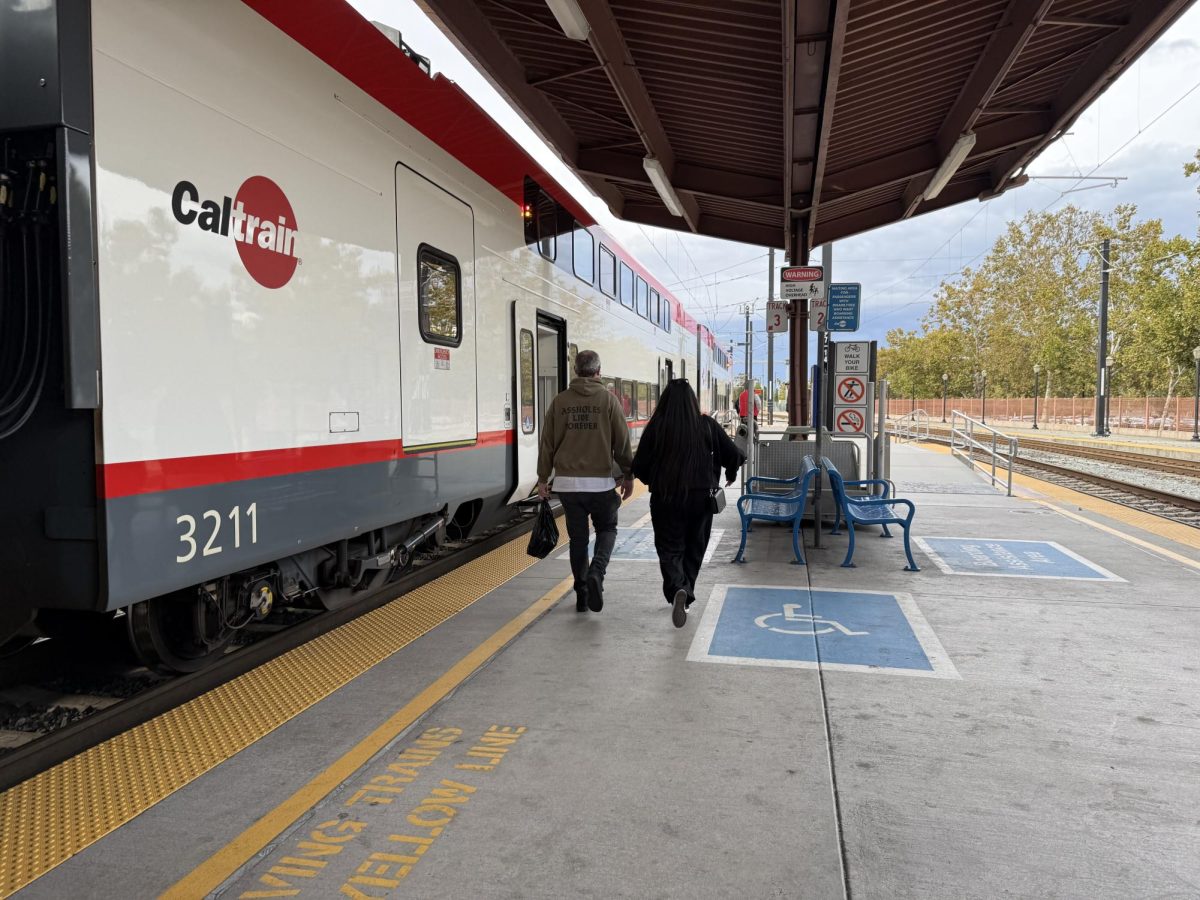
Anfisa Pitchkhadze
People walk to their bus stop at the Caltrain San José Diridon Station located at 65 Cahill Street, around a mile and a half west of the San José State campus.
Starting on Oct. 6, San José State students are able to get the Caltrain GoPass and experience unlimited rides on Caltrain.
Caltrain began in 1992 and is a commuter rail line that serves the San Francisco Peninsula area to San José and Gilroy, according to the Caltrain website.
The cost for the GoPass is for a one-time fee up to $99, but the price will be dependent when purchased within the coming months during the school year, according to the Associated Students Transportation Solutions webpage.
Haleema Bharoocha-Jobe, the A.S. Transportations Solutions department manager, said there was a strong demand from students for a more affordable access to Caltrain and Transportations Solutions had explored the GoPass option in June 2025 with a survey for students living in the Caltrain area.
“The response was overwhelmingly positive, with students expressing clear interest in having this pass,” Bharoocha-Jobe said.
GoPass will only be valid until July 31, 2026 and to be eligible, students must be enrolled to SJSU and open to Special Session and online-only students, according to the A.S. Transportation Solutions webpage.
“Transportation Solutions will evaluate the program’s impact, including student feedback before determining its future beyond the 2025-26 academic year,” Bharoocha-Jobe said.
Dan Lieberman, public information officer at Caltrain, said it would be up to SJSU if they want to continue with the GoPass program for students.
“As for the extension of the program, that decision is in SJSU’s court, but I would imagine the more students are taking advantage of the program, the more they would want to continue participating in it,” Lieberman said.
Lieberman said the GoPass program had initially started as a pilot program in 2003.
“The Nueva School in San Mateo joined the program in 2014, and we’ve been working with educational institutions ever since,” Lieberman said.
Other universities that benefit from the GoPass is Stanford University, according to the Stanford Transportation webpage.
The GoPass is not only offered to schools, but offered to work organizations with different tiered options, according to the Caltrain GoPass website.
The GoPass is not available to purchase for individual use, according to the same website.
Sam Jeffs, a second-year engineering technology student and part of BayPass at SJSU, hopes to see GoPass become popular to show the need for BayPass.
“We hope the popularity of the GoPass will strengthen the case for BayPass and show the need to expand from Caltrain to the greater Bay Area,” Jeffs said.
BayPass at SJSU is a student-led advocacy group, campaigning to have BayPass at SJSU for students to have affordable and unlimited public transportation, according to its Instagram account.
The Clipper BayPass program is a pilot program schools and work organizations participated in that was designed to measure how an all system pass would affect public transportation in the Bay Area, according to The Metropolitan Transportation Commission.
SJSU participated in Phase 1 of the BayPass pilot program from August 2022 to June 2025, according to a Sept. 4 article from the Spartan Daily.
“GoPass is an interim program that TS (A.S. Transportation Solutions) was able to launch in the short term to meet student needs while broader discussions continue about SJSU’s potential participation in BayPass Phase 2,” Bharoocha-Jobe said.
SJSU did not participate in Phase 2 of the BayPass program because a fee increase must go through the campus fee advisory committee vote and then through student referendum, according to the same article.
While GoPass can only be used for SJSU students that take Caltrain, the Clipper BayPass would allow SJSU students to use the 23 transit agencies across the Bay Area and give students more flexibility to travel, according to an article from BayPass at SJSU.
While GoPass costs $99 per academic year only to use Caltrain, the costs of BayPass would cost an individual $50 per academic year to use all transit agencies, according to BayPass.
“If SJSU participates in BayPass in the future, GoPass would be discontinued since BayPass already includes Caltrain service,” Bharoocha-Jobe said.
Eloisa Callueng, a second-year music education student, commutes from San Bruno to San José through Caltrain every day to get to campus.
“During the weekdays I would commute at 5:30 a.m. because it takes about an hour and a half to commute to SJSU,” Callueng said. “I have to commute early because I have an 8 a.m. class, and I also have to commute later through the day, which is at 9:30 p.m. because I have a class that ends around 9 p.m.”
It was reported that 37.28% of SJSU students’ primary commute method traveling to campus is through public transit, according to the SJSU Associated Students’ Transportation Solutions Fall 2024 Student Survey report.
Callueng said she had heard about GoPass before it was offered at SJSU for students and she tried reaching out to see if it was offered but not until this semester.
“Now it is offered, which is great because it saves me a lot of money since I spend about $200 a month for Caltrain,” Callueng said. “I think it is worth it but I also think it would be better if it was $100 per school year.”